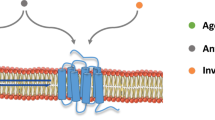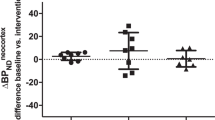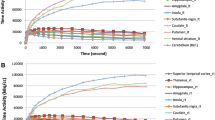Abstract
Purpose
The serotonin 2A (5-HT2A) receptor is of interest in several psychiatric and neurological diseases. In the present study we investigated the longitudinal stability of 5-HT2A receptors and the stability of the quantification procedure in the elderly in order to be able to study elderly patients with neuropsychiatric diseases on a longitudinal basis.
Methods
[18F]-Altanserin PET was used to quantify 5-HT2A receptors in 12 healthy elderly individuals at baseline and at 2 years in six volumes of interest. A bolus/infusion protocol was used to achieve the binding potential, BPP. The reproducibility as assessed in terms of variability and the reliability as assessed in terms of intraclass correlation coefficient (ICC) were used to compare inter- and intraobserver stability and to evaluate the effects of increasing complexity of partial volume (PV) corrections. We also compared the stability of our measurements over 2 years with the stability of data from an earlier study with 2-week test–retest measurements.
Results
BPP was unaltered at follow-up without the use of PV correction and when applying two-tissue PV correction, test–retest reproducibility was 12–15% and reliability 0.45–0.67 in the large bilateral regions such as the parietal, temporal, occipital and frontal cortices, while orbitofrontal and anterior cingulate cortical regions were less stable. The use of PV correction decreased the variability but also decreased the between-subject variation, thereby worsening the reliability.
Conclusion
In healthy elderly individuals, brain 5-HT2A receptor binding remains stable over 2 years, and acceptable reproducibility and reliability in larger regions and high intra- and interobserver stability allow the use of [18F]-altanserin in longitudinal studies of patients with neuropsychiatric disorders.


Similar content being viewed by others
References
Hasselbalch SG, Madsen K, Svarer C, Pinborg LH, Holm S, Paulson OB, et al. Reduced 5-HT(2A) receptor binding in patients with mild cognitive impairment. Neurobiol Aging 2007;(in press). DOI 10.1016/j.neurobiolaging.2007.04.011.
Meltzer CC, Price JC, Mathis CA, Greer PJ, Cantwell MN, Houck PR, et al. PET imaging of serotonin type 2A receptors in late-life neuropsychiatric disorders. Am J Psychiatry 1999;156:1871–78.
Adams KH, Pinborg LH, Svarer C, Hasselbalch SG, Holm S, Haugbol S, et al. A database of [(18)F]-altanserin binding to 5-HT(2A) receptors in normal volunteers: normative data and relationship to physiological and demographic variables. Neuroimage 2004;21:1105–13.
Meltzer CC, Smith G, DeKosky ST, Pollock BG, Mathis CA, Moore RY, et al. Serotonin in aging, late-life depression, and Alzheimer's disease: the emerging role of functional imaging. Neuropsychopharmacology 1998;18:407–30.
Pinborg LH, Adams KH, Svarer C, Holm S, Hasselbalch SG, Haugbol S, et al. Quantification of 5-HT2A receptors in the human brain using [18F]altanserin-PET and the bolus/infusion approach. J Cereb Blood Flow Metab 2003;23:985–96.
Haugbol S, Pinborg LH, Arfan HM, Frokjaer VM, Madsen J, Dyrby TB, et al. Reproducibility of 5-HT(2A) receptor measurements and sample size estimations with [(18)F]altanserin PET using a bolus/infusion approach. Eur J Nucl Med Mol Imaging 2007;34:910–15.
Woods RP, Cherry SR, Mazziotta JC. Rapid automated algorithm for aligning and reslicing PET images. J Comput Assist Tomogr 1992;16:620–33.
Svarer C, Madsen K, Hasselbalch SG, Pinborg LH, Haugbol S, Frokjaer VG, et al. MR-based automatic delineation of volumes of interest in human brain PET images using probability maps. Neuroimage 2005;24:969–79.
Quarantelli M, Berkouk K, Prinster A, Landeau B, Svarer C, Balkay L, et al. Integrated software for the analysis of brain PET/SPECT studies with partial-volume-effect correction. J Nucl Med 2004;45:192–201.
Meltzer CC, Leal JP, Mayberg HS, Wagner HN Jr., Frost JJ. Correction of PET data for partial volume effects in human cerebral cortex by MR imaging. J Comput Assist Tomogr 1990;14:561–70.
Muller-Gartner HW, Links JM, Prince JL, Bryan RN, McVeigh E, Leal JP, et al. Measurement of radiotracer concentration in brain gray matter using positron emission tomography: MRI-based correction for partial volume effects. J Cereb Blood Flow Metab 1992;12:571–83.
Adams KH. The in vivo brain distribution of serotonin 5-HT2A receptors in healthy subjects and in patients with obsessive-compulsive disorder: a positron emission study with [18F]-altanserin. PhD thesis, Copenhagen University, Faculty of Health Sciences; 2004.
Smith GS, Price JC, Lopresti BJ, Huang Y, Simpson N, Holt D, et al. Test-retest variability of serotonin 5-HT2A receptor binding measured with positron emission tomography and [18F]altanserin in the human brain. Synapse 1998;30:380–92.
Hammers A, Asselin MC, Turkheimer FE, Hinz R, Osman S, Hotton G, et al. Balancing bias, reliability, noise properties and the need for parametric maps in quantitative ligand PET: [(11)C]diprenorphine test-retest data. Neuroimage 2007;38:82–94.
Elmenhorst D, Meyer PT, Matusch A, Winz OH, Zilles K, Bauer A. Test-retest stability of cerebral A(1) adenosine receptor quantification using [(18)F]CPFPX and PET. Eur J Nucl Med Mol Imaging 2007;34:1061–70.
Neeb H, Zilles K, Shah NJ. Fully-automated detection of cerebral water content changes: study of age- and gender-related H2O patterns with quantitative MRI. Neuroimage 2006;29:910–22.
Takano A, Arakawa R, Hayashi M, Takahashi H, Ito H, Suhara T. Relationship between neuroticism personality trait and serotonin transporter binding. Biol Psychiatry 2007;62:588–92.
Frokjaer VG, Mortensen EL, Nielsen FA, Haugbol S, Pinborg LH, Adams KH, et al. Frontolimbic serotonin 2A receptor binding in healthy subjects is associated with personality risk factors for affective disorder. Biol Psychiatry 2008;63:569–76.
Roberts BW, DelVecchio WF. The rank-order consistency of personality traits from childhood to old age: a quantitative review of longitudinal studies. Psychol Bull 2000;126:3–25.
Pinborg LH, Arfan H, Haugbol S, Kyvik KO, Hjelmborg JV, Svarer C, et al. The 5-HT2A receptor binding pattern in the human brain is strongly genetically determined. Neuroimage 2008;40:1175–80.
Acknowledgments
We are grateful for financial support from the 1991 Pharmacy Foundation, the Health Insurance Foundation, the Lundbeck Foundation, the Danish Medical Research Council, and University Hospital Rigshospitalet. The John and Birthe Meyer Foundation is gratefully acknowledged for donation of the cyclotron and PET scanner. The study was funded in part by the EC-FP5 project NCI-MCI, QLK6-CT-2000-00502.
Conflicts of interest
None.
Author information
Authors and Affiliations
Corresponding author
Rights and permissions
About this article
Cite this article
Marner, L., Knudsen, G.M., Haugbøl, S. et al. Longitudinal assessment of cerebral 5-HT2A receptors in healthy elderly volunteers: an [18F]-altanserin PET study. Eur J Nucl Med Mol Imaging 36, 287–293 (2009). https://doi.org/10.1007/s00259-008-0945-4
Received:
Accepted:
Published:
Issue Date:
DOI: https://doi.org/10.1007/s00259-008-0945-4




